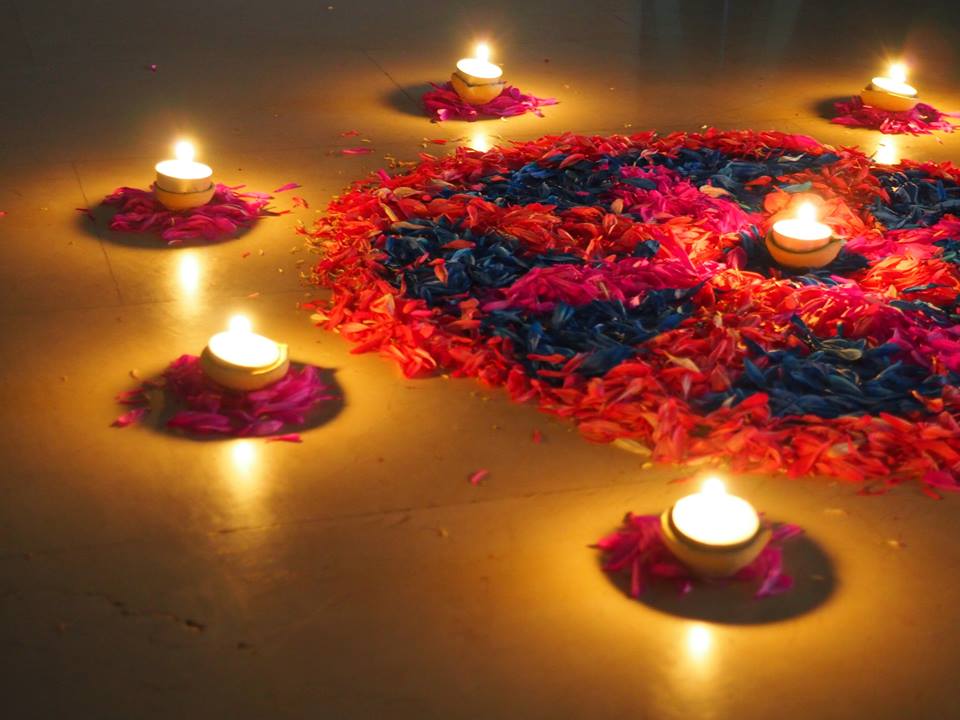My 4-year-old daughter, as is to be expected, has given much more thought to her Halloween costume (a caped pink rabbit) and the treats she will accumulate, than her snazzy new Diwali lengha and her grandmother’s homemade laddoos and barfis, her favorite South Asian desserts.
This year, Halloween is the day after Lakshmi Puja, the third day of Diwali, the five-day Hindu festival that celebrates the victory of good over evil. My family considers this day the most auspicious of the year. We believe that Lakshmi, the goddess of prosperity, visits our home. On this night of a new moon—the last night of the Hindu year—total darkness sets in the night sky.
As my daughter tries on her costume yet again, I reach for picture books and search Pinterest for age-appropriate Diwali crafts and recipes. I jot down recipes for salt dough to shape diyas, or tiny lamps. I find instructions on turning reams of construction paper into paper garlands. I Google rangoli, traditional floor art, and buy food coloring on Amazon. The irony that I turn to the tools of modern, privileged-class American parenting to explain my own religious holiday to my child is not lost on me.
RELATED: Is Raising Multilingual Kids a Huge Mistake?
In my life now, culture no longer just is>; it has to be made to be, and it is up to me to make it.
When I was a child, culture just was. My parents emigrated from India in the 1970s to seek a better life for themselves, their families and their future children. They settled in a township in Central New Jersey, which by the time I was in high school in the early 1990s became home to one of the largest South Asian American communities in the country. Ironically, despite being thousands of miles away from the only country and culture they ever knew, living in an ethnoburb allowed my parents to preserve our religion, heritage and customs with less effort than many of their acquaintances in other parts of the country.

Photograph by: Pooja Makhijani
Houses throughout our suburban subdivision were strung with twinkling strings of light. My mother and my “aunties,” the women in our neighborhood, assembled boxes of decadent sweets to exchange with each other. My girlfriends and I mixed and matched multicolored bangles to wear with our various salwar kameezes and traded tips on the best way to apply liquid eyeliner and lipstick. Our town and those nearby were dotted with Hindu temples, often housed in abandoned churches or community centers, and we shuttled from one to the next for holiday prayer services and music and dance performances.
There were certainly no crafts. Our immigrant families had neither the time nor the inclination. Instead, our loving aunties and uncles, our chosen families, taught us shlokas, devotional verses, and shared dessert recipes for the sake of nothing more than preserving.
I grew up, in many ways, more American than Indian, and I moved away from the communities of my childhood. I assimilated and acculturated, and lost a bit of my cultural identity in the process. This loss is acute, but not unexpected, and I’ve come to worry about what I am able to pass on to my daughter, and subsequently what she will be able to pass on to her children, should she choose to have them.
RELATED: First Birthday Traditions Around the World
In my life now, culture no longer just is>; it has to be made to be, and it is up to me to make it. Parenting a third-generation South Asian American child has given me a profound appreciation for the ways in which my parents transmitted generational and community knowledge. I can’t replicate exactly the mish-mash of traditions that my aunties and uncles tried to pass onto me, but I can create new rituals for my daughter, even if it means turning to the library or Instagram to teach her—and maybe me—about who we are.




